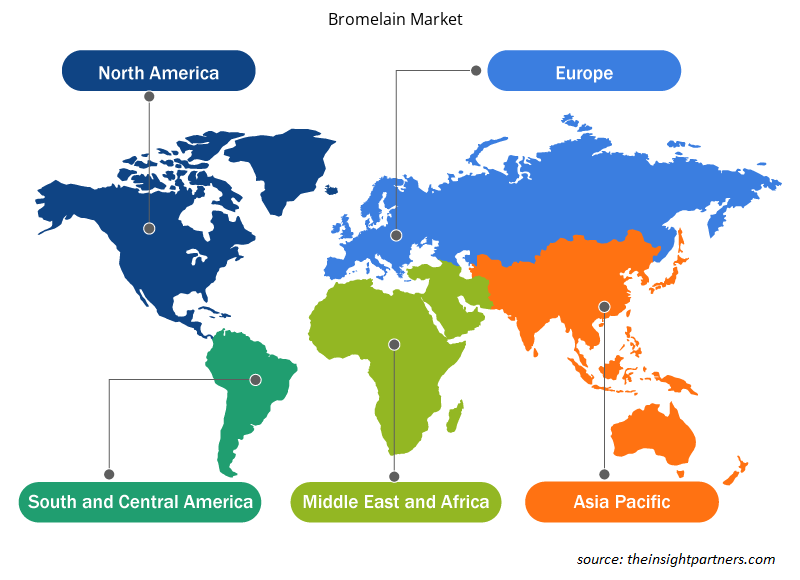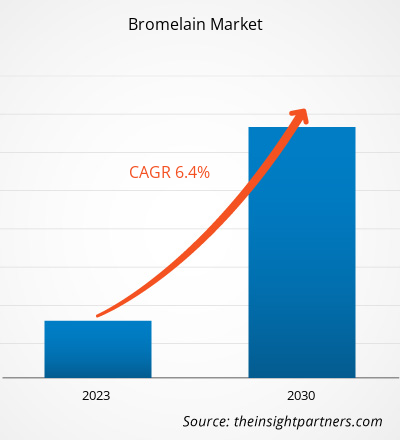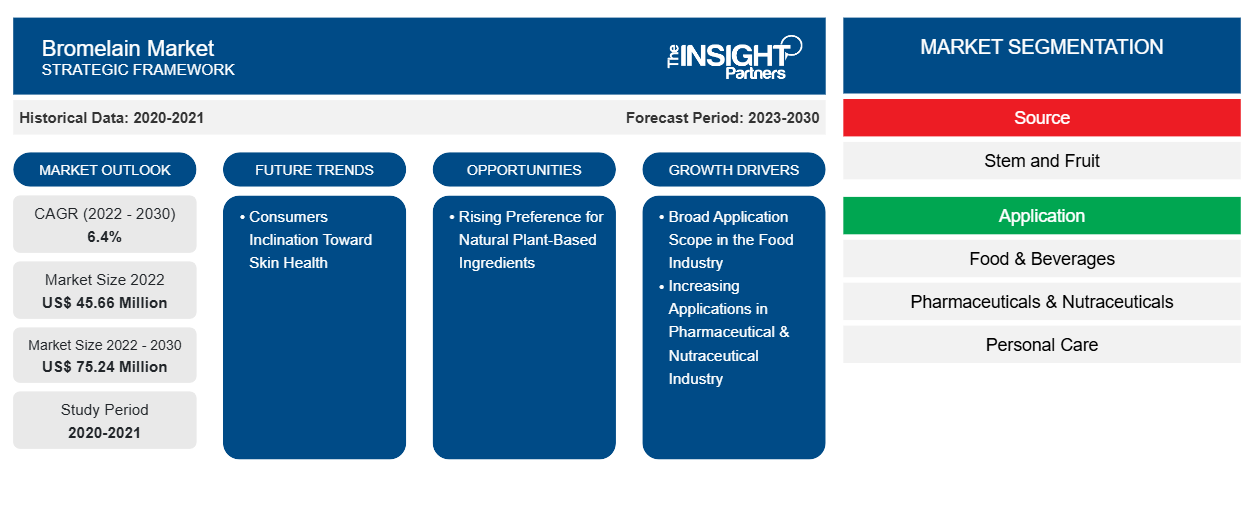[Forschungsbericht] Der Bromelain -Markt soll von 45,66 Millionen US-Dollar im Jahr 2022 auf 75,24 Millionen US-Dollar im Jahr 2030 anwachsen. Von 2022 bis 2030 wird für den Markt eine durchschnittliche jährliche Wachstumsrate (CAGR) von 6,4 % erwartet.
Markteinblicke und Analystenansichten:
Bromelain ist ein proteolytisches Enzym, das aus Ananas gewonnen wird. Ananasstiele und -früchte sind die wichtigsten Quellen für kommerziell extrahiertes Bromelain . Das Enzym findet vielfältige Anwendung in der Lebensmittel- und Getränkeindustrie, Pharmazeutika und Nutraceutika , Körperpflege, Ledergerbung, Textilindustrie, Tierfutter und Reinigungsmittelindustrie. Es wird verwendet, um Fleisch zart zu machen und Käse gerinnen zu lassen. Es wird auch als Klärmittel in Alkohol und als Bräunungsmittel in Fruchtsäften verwendet. In Pharmazeutika und Nutraceutika wird Bromelain wegen seiner entzündungshemmenden, therapeutischen und krebshemmenden Eigenschaften verwendet. In Kosmetika und Körperpflegeprodukten wird es aufgrund seiner Fähigkeit verwendet, Hautprobleme zu behandeln und das Bleichen von Zähnen zu erleichtern. Somit treibt die steigende Zahl der Anwendungen von Bromelain in verschiedenen Endverbrauchsindustrien das Marktwachstum voran.
Wachstumstreiber und Herausforderungen:
Verbraucher suchen zunehmend nach Produkten mit natürlichen Zusatzstoffen und Clean-Label-Inhaltsstoffen. Sie neigen dazu, sicherere Produkte zu konsumieren, die ihnen helfen, ihre allgemeine Gesundheit zu bewahren. Bromelain , ein natürliches Enzym aus der Ananaspflanze, wird in verschiedenen Branchen als natürlicher Zusatzstoff synthetischen Zusatzstoffen vorgezogen. Das wachsende Interesse an chemiefreien Produkten steigert die Nachfrage nach natürlichen Zusatzstoffen wie Bromelain in Branchen wie Pharmazie und Nutraceutika , Nahrungsmittel und Getränke sowie Kosmetik. Im Jahr 2006 stufte die US-amerikanische Food and Drug Administration (FDA) Bromelain als Lebensmittelzusatzstoff und allgemein als sicher anerkannte ( GRAS ) Substanz ein. Neben seinen medizinischen Anwendungen wird Bromelain zum Zartmachen von Fleisch, zur Klärung von Bier, zum Solubilisieren von Getreideproteinen und zum Backen von Keksen verwendet. In frischem Apfelsaft wird Bromelain als enzymatischer Bräunungshemmer verwendet. Der wachsende Fokus auf die Aufrechterhaltung einer optimalen Verdauungs- und Darmgesundheit steigert die Nachfrage nach Bromelain bei der Herstellung von Nahrungsergänzungsmitteln. Bromelain ist ein natürliches Enzym, das bemerkenswerte Peeling-Eigenschaften aufweist. Verbraucher entscheiden sich zunehmend für gesündere Methoden, um ihre Haut zum Strahlen zu bringen. Bromelain ist einer der wohltuenden Schönheitsstoffe, die eine gesunde Haut fördern, und wird daher häufig in der Kosmetikindustrie eingesetzt. Höhere Kosten, die mit den verschiedenen Produktionsstufen verbunden sind, wirken sich jedoch letztendlich auf die Gesamtpreise des fertigen Produkts aus, was das Wachstum des Bromelain- Marktes behindert.
Passen Sie diesen Bericht Ihren Anforderungen an
Sie erhalten kostenlose Anpassungen an jedem Bericht, einschließlich Teilen dieses Berichts oder einer Analyse auf Länderebene, eines Excel-Datenpakets sowie tolle Angebote und Rabatte für Start-ups und Universitäten.
-
Holen Sie sich die wichtigsten Markttrends aus diesem Bericht.Dieses KOSTENLOSE Beispiel umfasst eine Datenanalyse von Markttrends bis hin zu Schätzungen und Prognosen.
Berichtssegmentierung und -umfang:
Der globale Bromelain -Markt ist nach Quelle, Anwendung und Geografie segmentiert. Der Bromelain -Markt ist nach Typ in Stamm und Frucht unterteilt. Basierend auf der Anwendung ist der Markt in Lebensmittel und Getränke, Körperpflege, Pharmazeutika und Nutraceutika und andere unterteilt. Der Bromelain -Markt ist basierend auf der Geografie in Nordamerika (USA, Kanada und Mexiko), Europa (Deutschland, Frankreich, Italien, Großbritannien, Russland und Rest von Europa), Asien-Pazifik (Australien, China, Japan, Indien, Südkorea und Rest von Asien-Pazifik), Naher Osten und Afrika (Südafrika, Saudi-Arabien, Vereinigte Arabische Emirate und Rest von Nahem Osten und Afrika) und Süd- und Mittelamerika (Brasilien, Argentinien und Rest von Süd- und Mittelamerika) segmentiert.
Segmentanalyse :
Der Bromelain -Markt ist nach Quelle in Stamm und Frucht segmentiert. Das Stammsegment hält einen bedeutenden Marktanteil. Der Großteil des handelsüblichen Bromelains wird aus Ananasstängeln gewonnen, da dies eine günstigere Quelle ist, da es sich um einen nicht essbaren Teil der Frucht handelt. Stammbromelain hat in den USA den Status „allgemein als sicher angesehen“ ( GRAS ) erhalten und wird allgemein als Therapeutikum und Lebensmittelzusatzstoff akzeptiert . Es wird zur Behandlung von Bronchitis, Wunden, chirurgischen Traumata und Entzündungen verwendet. In der Lebensmittelindustrie wird dieses Enzym verwendet, um Fleisch zart zu machen, Alkohol zu klären und die Eigenschaften von Bäckerteig zu verbessern. In Kosmetika und Hautpflegeprodukten wird Stammbromelain wegen seiner heilenden Eigenschaften eingearbeitet. Diese Faktoren werden voraussichtlich das Wachstum des Segments im Prognosezeitraum vorantreiben.
Regionale Analyse:
Geografisch ist der Bromelain -Markt in fünf Hauptregionen unterteilt: Nordamerika, Europa, Asien-Pazifik, Süd- und Mittelamerika sowie Naher Osten und Afrika. Nordamerika dominierte den globalen Bromelain -Markt; der Markt in dieser Region wurde im Jahr 2022 auf 15.880 Millionen US-Dollar geschätzt. Für Europa wird im Prognosezeitraum eine durchschnittliche jährliche Wachstumsrate (CAGR) von 7,4 % auf dem Bromelain -Markt erwartet. Das Marktwachstum in Europa ist auf die zunehmende Akzeptanz von Bromelain in Kosmetika, Nahrungsergänzungsmitteln und anderen Anwendungen zurückzuführen. In der Backwarenindustrie wird Bromelain als Teigverbesserer und Geschmacksverstärker verwendet. Laut der UK Federation of Bakers Ltd ist die Backwarenindustrie einer der größten Beitragszahler im Lebensmittel- und Getränkesektor. Bromelain wird in Deutschland und anderen westeuropäischen Ländern häufig als Nahrungsergänzungsmittel verwendet. Es wird auch in Produkten zur Behandlung von Basal- und Nebenhöhlenentzündungen und Schwellungen nach einer Verletzung oder Operation verwendet. Diese Faktoren werden voraussichtlich das Wachstum des Bromelain -Marktes in der Region vorantreiben .
Der asiatisch-pazifische Raum nimmt mit fast 30 % den zweitgrößten Anteil des Bromelain -Marktes ein. Bromelain wird hauptsächlich in den Teilen der Welt produziert, in denen Ananas angebaut wird. Der asiatisch-pazifische Raum ist der weltweit größte Produzent von Ananas, was hauptsächlich auf optimale Landverfügbarkeit und günstige Temperaturbedingungen zurückzuführen ist; daher gibt es in der Region große Produktionseinheiten für Bromelain . Das Enzym wird im asiatisch-pazifischen Raum als nutrikosmetischer Bestandteil immer beliebter. Infolgedessen werden mit Bromelain angereicherte Gesichtsmasken und andere Kosmetikprodukte zu einem Hautpflegetrend, was dem Bromelain -Markt in dieser Region weiter zugutekommt.
Branchenentwicklungen und zukünftige Chancen:
Nachfolgend sind verschiedene Initiativen wichtiger Akteure auf dem Bromelain-Markt aufgeführt:
- Im August 2021 brachte das in Belgien ansässige Unternehmen ENZYBEL GROUP Bromelain K auf den Markt, ein neues Produkt, das speziell für Anwendungen wie Fleischzartmachung, Proteinhydrolyse und Geschmacksverstärkung im Lebensmittel- und Getränkesektor entwickelt wurde.
Auswirkungen von COVID-19:
Die COVID-19-Pandemie betraf fast alle Branchen in verschiedenen Ländern. Lockdowns, Reisebeschränkungen und Betriebsschließungen in Nordamerika, Europa, Asien-Pazifik (APAC), Süd- und Mittelamerika (SAM) sowie dem Nahen Osten und Afrika (MEA) behinderten das Wachstum mehrerer Branchen, darunter der Lebensmittel- und Getränkeindustrie, der Körperpflege- und der Textilindustrie. Die Schließung von Produktionseinheiten störte globale Lieferketten, Produktionsaktivitäten, Lieferpläne sowie den Verkauf lebenswichtiger und nicht lebenswichtiger Produkte. Verschiedene Unternehmen erlebten im Jahr 2020 Verzögerungen bei Produktlieferungen und einen Einbruch der Verkäufe ihrer Produkte, was den Bromelain-Markt behinderte. Der Mangel an Arbeitskräften und die begrenzte Versorgung mit Rohstoffen führten während der COVID-19-Pandemie auch zu einem Stillstand von Betrieben und Prozessen auf der ganzen Welt. Diese Faktoren wirkten sich während der Pandemie negativ auf das Marktwachstum aus.
Andererseits hat sich die Nachfrage nach Bromelain als funktioneller Zutat in Nutrazeutika in den letzten Jahren erhöht, da sich der Fokus der Verbraucher während dieser Gesundheitskrise auf die Stärkung ihres Immunsystems und ihres Wohlbefindens verlagert hat. Im Jahr 2021 nahmen verschiedene Volkswirtschaften ihren Betrieb wieder auf, da mehrere Regierungen die zuvor verhängten Beschränkungen aufhoben, was sich positiv auf den Weltmarkt auswirkte. Darüber hinaus durften die Hersteller mit voller Kapazität arbeiten, was ihnen half, die Nachfrage- und Angebotslücken zu überwinden.
Regionale Einblicke in den Bromelain-Markt
Die regionalen Trends und Faktoren, die den Bromelain-Markt während des Prognosezeitraums beeinflussen, wurden von den Analysten von Insight Partners ausführlich erläutert. In diesem Abschnitt werden auch die Bromelain-Marktsegmente und die Geografie in Nordamerika, Europa, im asiatisch-pazifischen Raum, im Nahen Osten und Afrika sowie in Süd- und Mittelamerika erörtert.

- Holen Sie sich die regionsspezifischen Daten zum Bromelain-Markt
Umfang des Bromelain-Marktberichts
| Berichtsattribut | Details |
|---|---|
| Marktgröße im Jahr 2022 | 45,66 Millionen US-Dollar |
| Marktgröße bis 2030 | 75,24 Millionen US-Dollar |
| Globale CAGR (2022 - 2030) | 6,4 % |
| Historische Daten | 2020-2021 |
| Prognosezeitraum | 2023–2030 |
| Abgedeckte Segmente |
Nach Quelle
|
| Abgedeckte Regionen und Länder |
Nordamerika
|
| Marktführer und wichtige Unternehmensprofile |
|
Bromelain-Marktteilnehmerdichte: Die Auswirkungen auf die Geschäftsdynamik verstehen
Der Bromelain-Markt wächst rasant, angetrieben durch die steigende Nachfrage der Endverbraucher aufgrund von Faktoren wie sich entwickelnden Verbraucherpräferenzen, technologischen Fortschritten und einem größeren Bewusstsein für die Vorteile des Produkts. Mit steigender Nachfrage erweitern Unternehmen ihr Angebot, entwickeln Innovationen, um die Bedürfnisse der Verbraucher zu erfüllen, und nutzen neue Trends, was das Marktwachstum weiter ankurbelt.
Die Marktteilnehmerdichte bezieht sich auf die Verteilung der Firmen oder Unternehmen, die in einem bestimmten Markt oder einer bestimmten Branche tätig sind. Sie gibt an, wie viele Wettbewerber (Marktteilnehmer) in einem bestimmten Marktraum im Verhältnis zu seiner Größe oder seinem gesamten Marktwert präsent sind.
Die wichtigsten auf dem Bromelain-Markt tätigen Unternehmen sind:
- Hong Mao Biochemicals Co Ltd
- Enzybel International SA
- Enzyme Technologies (Pty) Ltd
- Guangxi Nanning Javely Biologische Produkte Co Ltd
- Kreative Enzyme
Haftungsausschluss : Die oben aufgeführten Unternehmen sind nicht in einer bestimmten Reihenfolge aufgeführt.

- Überblick über die wichtigsten Akteure auf dem Bromelain-Markt
Wettbewerbslandschaft und Schlüsselunternehmen:
Zu den führenden Akteuren auf dem globalen Bromelain-Markt zählen Hong Mao Biochemicals Co Ltd, Enzybel International SA, Enzyme Technologies (Pty) Ltd, Guangxi Nanning Javely Biological Products Co Ltd, Creative Enzymes, Medikonda Nutrients, Changsha Natureway Co Ltd, Antozyme Biotech Pvt Ltd, Challenge Bioproducts Co Ltd und Great Food (Biochem) Co Ltd. Diese Marktteilnehmer ergreifen strategische Entwicklungsinitiativen zur Expansion und treiben so das Wachstum des Bromelain-Marktes weiter voran.
- Historische Analyse (2 Jahre), Basisjahr, Prognose (7 Jahre) mit CAGR
- PEST- und SWOT-Analyse
- Marktgröße Wert/Volumen – Global, Regional, Land
- Branchen- und Wettbewerbslandschaft
- Excel-Datensatz
Aktuelle Berichte
Erfahrungsberichte
Grund zum Kauf
- Fundierte Entscheidungsfindung
- Marktdynamik verstehen
- Wettbewerbsanalyse
- Kundeneinblicke
- Marktprognosen
- Risikominimierung
- Strategische Planung
- Investitionsbegründung
- Identifizierung neuer Märkte
- Verbesserung von Marketingstrategien
- Steigerung der Betriebseffizienz
- Anpassung an regulatorische Trends























 Kostenlose Probe anfordern für - Bromelain-Markt
Kostenlose Probe anfordern für - Bromelain-Markt